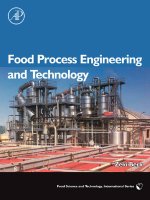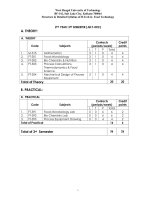Rheological methods in food process engineering
Bạn đang xem bản rút gọn của tài liệu. Xem và tải ngay bản đầy đủ của tài liệu tại đây (1.3 MB, 428 trang )
RHEOLOGICAL METHODS IN
FOOD PROCESS ENGINEERING
Second Edition
James F. Steffe, Ph.D., P.E.
Professor of Food Process Engineering
Dept. of Food Science and Human Nutrition
Dept. of Agricultural Engineering
Michigan State University
Freeman Press
2807 Still Valley Dr.
East Lansing, MI 48823
USA
Prof. James F. Steffe
209 Farrall Hall
Michigan State University
East Lansing, MI 48824-1323
USA
Phone: 517-353-4544
FAX: 517-432-2892
E-mail:
URL: www.egr.msu.edu/~steffe/
Copyright 1992, 1996 by James F. Steffe.
All rights reserved. No part of this work may be reproduced,
stored in a retrieval system, or transmitted, in any form or by any
means, electronic, mechanical, photocopying, recording, or other-
wise, without the prior written permission of the author.
Printed on acid-free paper in the United States of America
Second Printing
Library of Congress Catalog Card Number: 96-83538
International Standard Book Number: 0-9632036-1-4
Freeman Press
2807 Still Valley Dr.
East Lansing, MI 48823
USA
Table of Contents
Preface ix
Chapter 1. Introduction to Rheology 1
1.1. Overview 1
1.2. Rheological Instruments for Fluids 2
1.3. Stress and Strain 4
1.4. Solid Behavior 8
1.5. Fluid Behavior in Steady Shear Flow 13
1.5.1. Time-Independent Material Functions 13
1.5.2. Time-Dependent Material Functions 27
1.5.3. Modeling Rheological Behavior of Fluids 32
1.6. Yield Stress Phenomena 35
1.7. Extensional Flow 39
1.8. Viscoelastic Material Functions 47
1.9. Attacking Problems in Rheological Testing 49
1.10. Interfacial Rheology 53
1.11. Electrorheology 55
1.12. Viscometers for Process Control and Monitoring 57
1.13. Empirical Measurement Methods for Foods 63
1.14. Example Problems 77
1.14.1. Carrageenan Gum Solution 77
1.14.2. Concentrated Corn Starch Solution 79
1.14.3. Milk Chocolate 81
1.14.4. Falling Ball Viscometer for Honey 82
1.14.5. Orange Juice Concentrate 86
1.14.6. Influence of the Yield Stress in Coating Food 91
Chapter 2. Tube Viscometry 94
2.1. Introduction 94
2.2. Rabinowitsch-Mooney Equation 97
2.3. Laminar Flow Velocity Profiles 103
2.4. Laminar Flow Criteria 107
2.5. Data Corrections 110
2.6. Yield Stress Evaluation 121
2.7. Jet Expansion 121
2.8. Slit Viscometry 122
2.9. Glass Capillary (U-Tube) Viscometers 125
2.10. Pipeline Design Calculations 128
2.11. Velocity Profiles In Turbulent Flow 138
2.12. Example Problems 141
2.12.1. Conservation of Momentum Equations 141
2.12.2. Capillary Viscometry - Soy Dough 143
2.12.3. Tube Viscometry - 1.5% CMC 146
2.12.4. Casson Model: Flow Rate Equation 149
2.12.5. Slit Viscometry - Corn Syrup 150
2.12.6. Friction Losses in Pumping 152
2.12.7. Turbulent Flow - Newtonian Fluid 155
2.12.8. Turbulent Flow - Power Law Fluid 156
v
Chapter 3. Rotational Viscometry 158
3.1. Introduction 158
3.2. Concentric Cylinder Viscometry 158
3.2.1. Derivation of the Basic Equation 158
3.2.2. Shear Rate Calculations 163
3.2.3. Finite Bob in an Infinite Cup 168
3.3. Cone and Plate Viscometry 169
3.4. Parallel Plate Viscometry (Torsional Flow) 172
3.5. Corrections: Concentric Cylinder 174
3.6. Corrections: Cone and Plate, and Parallel Plate 182
3.7. Mixer Viscometry 185
3.7.1. Mixer Viscometry: Power Law Fluids 190
3.7.2. Mixer Viscometry: Bingham Plastic Fluids 199
3.7.3. Yield Stress Calculation: Vane Method 200
3.7.4. Investigating Rheomalaxis 208
3.7.5. Defining An Effective Viscosity 210
3.8. Example Problems 210
3.8.1. Bob Speed for a Bingham Plastic Fluid 210
3.8.2. Simple Shear in Power Law Fluids 212
3.8.3. Newtonian Fluid in a Concentric Cylinder 213
3.8.4. Representative (Average) Shear Rate 214
3.8.5. Concentric Cylinder Viscometer: Power Law Fluid 216
3.8.6. Concentric Cylinder Data - Tomato Ketchup 218
3.8.7. Infinite Cup - Single Point Test 221
3.8.8. Infinite Cup Approximation - Power Law Fluid 221
3.8.9. Infinite Cup - Salad Dressing 223
3.8.10. Infinite Cup - Yield Stress Materials 225
3.8.11. Cone and Plate - Speed and Torque Range 226
3.8.12. Cone and Plate - Salad Dressing 227
3.8.13. Parallel Plate - Methylcellulose Solution 229
3.8.14. End Effect Calculation for a Cylindrical Bob 231
3.8.15. Bob Angle for a Mooney-Couette Viscometer 233
3.8.16. Viscous Heating 235
3.8.17. Cavitation in Concentric Cylinder Systems 236
3.8.18. Mixer Viscometry 237
3.8.19. Vane Method - Sizing the Viscometer 243
3.8.20. Vane Method to Find Yield Stresses 244
3.8.21. Vane Rotation in Yield Stress Calculation 247
3.8.22. Rheomalaxis from Mixer Viscometer Data 250
Chapter 4. Extensional Flow 255
4.1. Introduction 255
4.2. Uniaxial Extension 255
4.3. Biaxial Extension 258
4.4. Flow Through a Converging Die 263
4.4.1. Cogswell’s Equations 264
4.4.2. Gibson’s Equations 268
4.4.3. Empirical Method 271
4.5. Opposing Jets 272
4.6. Spinning 274
4.7. Tubeless Siphon (Fano Flow) 276
vi
4.8. Steady Shear Properties from Squeezing Flow Data 276
4.8.1. Lubricated Squeezing Flow 277
4.8.2. Nonlubricated Squeezing Flow 279
4.9. Example Problems 283
4.9.1. Biaxial Extension of Processed Cheese Spread 283
4.9.2. Biaxial Extension of Butter 286
4.9.3. 45 Converging Die, Cogswell’s Method 287
4.9.4. 45 Converging Die, Gibson’s Method 289
4.9.5. Lubricated Squeezing Flow of Peanut Butter 291
Chapter 5. Viscoelasticity 294
5.1. Introduction 294
5.2. Transient Tests for Viscoelasticity 297
5.2.1. Mechanical Analogues 298
5.2.2. Step Strain (Stress Relaxation) 299
5.2.3. Creep and Recovery 304
5.2.4. Start-Up Flow (Stress Overshoot) 310
5.3. Oscillatory Testing 312
5.4. Typical Oscillatory Data 324
5.5. Deborah Number 332
5.6. Experimental Difficulties in Oscillatory Testing of Food 336
5.7. Viscometric and Linear Viscoelastic Functions 338
5.8. Example Problems 341
5.8.1. Generalized Maxwell Model of Stress Relaxation 341
5.8.2. Linearized Stress Relaxation 342
5.8.3. Analysis of Creep Compliance Data 343
5.8.4. Plotting Oscillatory Data 348
6. Appendices 350
6.1. Conversion Factors and SI Prefixes 350
6.2. Greek Alphabet 351
6.3. Mathematics: Roots, Powers, and Logarithms 352
6.4. Linear Regression Analysis of Two Variables 353
6.5. Hookean Properties 357
6.6. Steady Shear and Normal Stress Difference 358
6.7. Yield Stress of Fluid Foods 359
6.8. Newtonian Fluids 361
6.9. Dairy, Fish and Meat Products 366
6.10. Oils and Miscellaneous Products 367
6.11. Fruit and Vegetable Products 368
6.12. Polymer Melts 371
6.13. Cosmetic and Toiletry Products 372
6.14. Energy of Activation for Flow for Fluid Foods 374
6.15. Extensional Viscosities of Newtonian Fluids 375
6.16. Extensional Viscosities of Non-Newtonian Fluids 376
6.17. Fanning Friction Factors: Bingham Plastics 377
6.18. Fanning Friction Factors: Power Law Fluids 378
6.19. Creep (Burgers Model) of Salad Dressing 379
6.20. Oscillatory Data for Butter 380
6.21. Oscillatory Data Iota-Carrageenan Gel 381
6.22. Storage and Loss Moduli of Fluid Foods 382
°
°
vii
Nomenclature 385
Bibliography 393
Index 412
viii
Preface
Growth and development of this work sprang from the need to
provide educational material for food engineers and food scientists. The
first edition was conceived as a textbook and the work continues to be
used in graduate level courses at various universities. Its greatest
appeal, however, was to individuals solving practical day-to-day prob-
lems. Hence, the second edition, a significantly expanded and revised
version of the original work, is aimed primarily at the rheological
practitioner (particularly the industrial practitioner) seeking a broad
understanding of the subject matter. The overall goal of the text is to
present the information needed to answer three questions when facing
problems in food rheology: 1. What properties should be measured? 2.
What type and degree of deformation should be induced in the mea-
surement? 3. How should experimental data be analyzed to generate
practical information? Although the main focus of the book is food,
scientists and engineers in other fields will find the work a convenient
reference for standard rheological methods and typical data.
Overall, the work presents the theory of rheological testing and
provides the analytical tools needed to determine rheological properties
from experimental data. Methods appropriate for common food industry
applications are presented. All standard measurement techniques for
fluid and semi-solid foods are included. Selected methods for solids are
also presented. Results from numerous fields, particularly polymer
rheology, are used to address the flow behavior of food. Mathematical
relationships, derived from simple force balances, provide a funda-
mental view of rheological testing. Only a background in basic calculus
and elementary statistics (mainly regression analysis) is needed to
understand thematerial. The text containsnumerous practicalexample
problems, involving actual experimental data, to enhance comprehen-
sion and the execution of concepts presented. This feature makes the
work convenient for self-study.
Specific explanations of key topics in rheology are presented in
Chapter 1: basic concepts of stress and strain; elastic solids showing
Hookean and non-Hookean behavior; viscometric functions including
normal stress differences; modeling fluid behavior as a function of shear
rate, temperature, and composition; yield stress phenomena, exten-
sional flow; and viscoelastic behavior. Efficient methods of attacking
problems and typical instruments used to measure fluid properties are
discussed along with an examination of problems involving interfacial
ix
rheology, electrorheology, and on-line viscometry for control and mon-
itoring of food processing operations. Common methods and empirical
instruments utilized in the food industry are also introduced: Texture
Profile Analysis, Compression-Extrusion Cell, Warner-Bratzler Shear
Cell, Bostwick Consistometer, Adams Consistometer, Amylograph,
Farinograph, Mixograph, Extensigraph, Alveograph, Kramer Shear
Cell, Brookfield disks and T-bars, Cone Penetrometer, Hoeppler Vis-
cometer, Zhan Viscometer, Brabender-FMC Consistometer.
The basic equations of tube (or capillary) viscometry, such as the
Rabinowitsch-Mooney equation, are derived and applied in Chapter 2.
Laminar flow criteria and velocity profiles are evaluated along with data
correction methods for many sources of error: kinetic energy losses, end
effects, slip (wall effects), viscous heating, and hole pressure. Tech-
niques for glass capillary and slit viscometers are considered in detail.
A section on pipeline design calculations has been included to facilitate
the construction of large scale tube viscometers and the design of fluid
pumping systems.
A general format, analogous to that used in Chapter 2, is continued
in Chapter 3 to provide continuity in subject matter development. The
main foci of the chapter center around the theoretical principles and
experimental procedures related to three traditional types of rotational
viscometers: concentric cylinder, cone and plate, and parallel plate.
Mathematical analyses of data are discussed in detail. Errors due to
end effects, viscous heating, slip, Taylor vortices, cavitation, and cone
truncations are investigated. Numerous methods in mixer viscometry,
techniques having significant potential to solve many food rheology
problems, are also presented: slope and matching viscosity methods to
evaluate average shear rate, determination of power law and Bingham
plastic fluid properties. The vane method of yield stress evaluation,
using both the slope and single point methods, along with a consider-
ation of vane rotation during testing, is explored in detail.
The experimental methods to determine extensional viscosity are
explained in Chapter 4. Techniques presented involve uniaxial exten-
sion between rotating clamps, biaxial extensional flow achieved by
squeezing material between lubricated parallel plates, opposing jets,
spinning, and tubeless siphon (Fano) flow. Related procedures,
involving lubricated and nonlubricated squeezing, to determine shear
flow behavior are also presented. Calculating extensional viscosity from
flows through tapered convergences and flat entry dies is given a
thorough examination.
x
Essential concepts in viscoelasticity and standard methods of
investigating the phenomenon are investigated in Chapter 5. The full
scope of viscoelastic material functions determined in transient and
oscillatory testing are discussed. Mechanical analogues of rheological
behavior are given as a means of analyzing creep and stress relaxation
data. Theoretical aspects of oscillatory testing, typical data, and a
discussion of the various modes of operating commercial instruments
-strain, frequency, time, and temperature sweep modes- are presented.
The Deborah number concept, and how it can be used to distinguish
liquid from solid-like behavior, is introduced. Start-up flow (stress
overshoot) and the relationship between steady shear and oscillatory
properties are also discussed. Conversion factors, mathematical rela-
tionships, linear regression analysis, and typical rheological data for
food as well as cosmetics and polymers are provided in the Appendices.
Nomenclature is conveniently summarized at the end of the text and a
large bibliography is furnished to direct readers to additional infor-
mation.
J.F. Steffe
June, 1996
xi
Dedication
To Susan, Justinn, and Dana.
xiii
Chapter 1. Introduction to Rheology
1.1. Overview
The first use of the word "rheology" is credited to Eugene C. Bingham
(circa 1928) who also described the motto of the subject as
("panta rhei," from the works of Heraclitus, a pre-Socratic Greek phi-
losopher active about 500 B.C.) meaning "everything flows" (Reiner,
1964). Rheology is nowwell established as the scienceof the deformation
and flow of matter: It is the study of the manner in which materials
respond to applied stress or strain. All materials have rheological
properties and the area is relevant in many fields of study: geology and
mining (Cristescu, 1989), concrete technology (Tattersall and Banfill,
1983), soil mechanics (Haghighi et al., 1987; Vyalov, 1986), plastics
processing (Dealy and Wissburn, 1990), polymers and composites
(Neilsen and Landel, 1994; Yanovsky, 1993), tribology (study of lubri-
cation, friction and wear), paint flow and pigment dispersion (Patton,
1964), blood (Dintenfass, 1985), bioengineering (Skalak and Chien,
1987), interfacial rheology (Edwards et al., 1991), structural materials
(Callister, 1991), electrorheology (Block and Kelly, 1988), psychor-
heology (Drake, 1987), cosmetics and toiletries (Laba, 1993b), and
pressure sensitive adhesion (Saunders et al., 1992). The focus of this
work is food where understanding rheology is critical in optimizing
product development efforts, processing methodology and final product
quality. To the extent possible, standard nomenclature (Dealy, 1994)
has been used in the text.
One can think of food rheology as the material science of food. There
are numerous areas where rheological data are needed in the food
industry:
a. Process engineering calculations involving a wide range of equip-
ment such as pipelines, pumps, extruders, mixers, coaters, heat
exchangers, homogenizers, calenders, and on-line viscometers;
b. Determining ingredient functionality in product development;
c. Intermediate or final product quality control;
d. Shelf life testing;
e. Evaluation of food texture by correlation to sensory data;
f. Analysis of rheological equations of state or constitutive equations.
Many of the unique rheological properties of various foods have been
summarized in books by Rao and Steffe (1992), andWeipert et al. (1993).
πανταρει
2 Chapter 1. Introduction to Rheology
Fundamental rheological properties are independent of the instru-
ment on which they are measured so different instruments will yield
the same results. This is an ideal concept and different instruments
rarely yield identical results; however, the idea is one which distin-
guishes true rheological material properties from subjective (empirical
and generally instrument dependent, though frequently useful)
material characterizations. Examples of instruments giving subjective
results include the following (Bourne, 1982): Farinograph, Mixograph,
Extensograph, Viscoamlyograph, and the Bostwick Consistometer.
Empirical testing devices and methods, including Texture Profile
Analysis, are considered in more detail in Sec. 1.13.
1.2. Rheological Instruments for Fluids
Common instruments, capable of measuring fundamental rheolog-
ical properties of fluid and semi-solid foods, may be placed into two
general categories (Fig. 1.1): rotational type and tube type. Most are
commercially available, others (mixer and pipe viscometers) are easily
fabricated. Costs vary tremendously from the inexpensive glass capil-
lary viscometer to a very expensive rotational instrument capable of
measuring dynamic properties and normal stress differences. Solid
foods are often tested in compression (between parallel plates), tension,
or torsion. Instruments which measure rheological properties are called
rheometers. Viscometer is a more limiting term referring to devices
that only measure viscosity.
Rotational instruments may be operated in the steady shear (con-
stant angular velocity) or oscillatory (dynamic) mode. Some rotational
instruments function in the controlled stress mode facilitating the
collection of creep data, the analysis of materials at very low shear rates,
and the investigation of yield stresses. This information is needed to
understand the internal structure of materials. The controlled rate
mode is most useful in obtaining data required in process engineering
calculations. Mechanical differences between controlled rate and con-
trolled stress instruments are discussed in Sec. 3.7.3. Rotational sys-
tems are generallyused to investigate time-dependent behavior because
tube systems only allow one pass of the material through the apparatus.
A detailed discussion of oscillatory testing, the primary method of
determining the viscoelastic behavior of food, is provided in Chapter 5.
1.2 Rheological Instruments for Fluids 3
Figure 1.1. Common rheological instruments divided into two major categories:
rotational and tube type.
There are advantages and disadvantages associated with each
instrument. Gravity operated glass capillaries, such as the Cannon-
Fenske type shown in Fig. 1.1, are only suitable for Newtonian fluids
because the shear rate varies during discharge. Cone and plate systems
are limited to moderate shear rates but calculations (for small cone
angles) are simple. Pipe and mixer viscometers can handle much larger
particles than cone and plate, or parallel plate, devices. Problems
associated with slip and degradation in structurally sensitive materials
are minimized with mixer viscometers. High pressure capillaries
operate at high shear rates but generally involve a significant end
pressure correction. Pipe viscometers can be constructed to withstand
the rigors of the production or pilot plant environment.
Rotational Type
Parallel Plate Cone and Plate
Concentric Cylinder
Mixer
Tube Type
Pipe
Glass Capillary High Pressure Capillary
4 Chapter 1. Introduction to Rheology
All the instrumentspresented in Fig. 1.1 are"volume loaded" devices
with container dimensions that are critical in the determination of
rheological properties. Another common type of instrument, known as
a vibrational viscometer, uses the principle of "surface loading" where
the surface of an immersed probe (usually a sphere or a rod) generates
a shear wave which dissipates in the surrounding medium. A large
enough container is used so shear forces do not reach the wall and reflect
back to the probe. Measurements depend only on ability of the sur-
rounding fluid to damp probe vibration. The damping characteristic of
a fluid is a function of the product of the fluid viscosity (of Newtonian
fluids) and the density. Vibrational viscometers are popular as in-line
instruments for process control systems (see Sec. 1.12). It is difficult to
use these units to evaluate fundamental rheological properties of non-
Newtonian fluids (Ferry, 1977), but the subjective results obtained often
correlate well with important food quality attributes. The coagulation
time and curd firmness of renneted milk, for example, have been suc-
cessfully investigated using a vibrational viscometer (Sharma et al.,
1989).
Instruments used to evaluate the extensional viscosity of materials
are discussed in Chapter 4. Pulling or stretching a sample between
toothed gears, sucking material into opposing jets, spinning, or
exploiting the open siphon phenomenon can generate data for calcu-
lating tensile extensional viscosity. Information to determine biaxial
extensional viscosity is provided by compressing samples between
lubricated parallel plates. Shear viscosity can also be evaluated from
unlubricated squeezing flow between parallel plates. A number of
methods are available to calculate an average extensional viscosity from
data describing flow through a convergence into a capillary die or slit.
1.3. Stress and Strain
Since rheologyis thestudy of the deformationof matter, it isessential
to have a good understanding of stress and strain. Consider a rectan-
gular bar that, due to a tensile force, is slightly elongated (Fig. 1.2). The
initial length of the bar is and the elongated length is where
with representing the increase in length. This deformation
may be thought of in terms of Cauchy strain (also called engineering
strain):
L
o
L
L = L
o
+δL δL
1.3 Stress and Strain 5
[1.1]
or Hencky strain (also called true strain) which is determined by
evaluating an integral from to :
[1.2]
Figure 1.2. Linear extension of a rectangular bar.
Cauchy and Hencky strains are both zero when the material is
unstrained and approximately equal at small strains. The choice of
which strain measure to use is largely a matter of convenience and one
can be calculated from the other:
[1.3]
is preferred for calculating strain resulting from a large deformation.
Another type of deformation commonly found in rheology is simple
shear. The idea can be illustrated with a rectangular bar (Fig. 1.3) of
height . The lower surface is stationary and the upper plate is linearly
displaced by an amount equal to . Each element is subject to the same
level of deformation so the size of the element is not relevant. The angle
of shear, , may be calculated as
ε
c
=
δL
L
o
=
L − L
o
L
o
=
L
L
o
− 1
L
o
L
ε
h
=
⌠
⌡
L
o
L
dL
L
=ln(L/L
o
)
L
L
0
ε
h
= ln(1+ε
c
)
ε
h
h
δL
γ
6 Chapter 1. Introduction to Rheology
[1.4]
With small deformations, the angle of shear (in radians) is equal to the
shear strain (also symbolized by ), .
Figure 1.3. Shear deformation of a rectangular bar.
Figure 1.4. Typical stresses on a material element.
Stress, defined as a force per unit area and usually expressed in
Pascal (N/m
2
), may be tensile, compressive, or shear. Nine separate
quantities are required to completely describe the state of stress in a
material. A small element (Fig. 1.4) may be considered in terms of
tan(γ) =
δL
h
γ tanγ=γ
h
L
11
21
23
22
33
1
2
3
x
x
x
1.3 Stress and Strain 7
Cartesian coordinates ( ). Stress is indicated as where the first
subscript refers to the orientation of the face upon which the force acts
and the second subscript refers to the direction of the force. Therefore,
is a normal stress acting in the plane perpendicular to in the
direction of and is a shear stress acting in the plane perpendicular
to in the direction of . Normal stresses are considered positive when
they act outward (acting to create a tensile stress) and negative when
they act inward (acting to create a compressive stress).
Stress components may be summarized as a stress tensor written
in the form of a matrix:
[1.5]
A related tensor for strain can also be expressed in matrix form. Basic
laws of mechanics, considering the moment about the axis under
equilibrium conditions, can be used to prove that the stress matrix is
symmetrical:
[1.6]
so
[1.7]
[1.8]
[1.9]
meaning there are only six independent components in the stress tensor
represented by Eq. [1.5].
Equations that show the relationship between stress and strain are
either called rheological equations of state or constitutive equations. In
complex materials these equations may include other variables such as
time, temperature, and pressure. A modulus is defined as the ratio of
stress to strain while a compliance is defined as the ratio of strain to
stress. The word rheogram refersto agraph ofa rheological relationship.
x
1
,x
2
,x
3
σ
ij
σ
11
x
1
x
1
σ
23
x
2
x
3
σ
ij
=
σ
11
σ
12
σ
13
σ
21
σ
22
σ
23
σ
31
σ
32
σ
33
σ
ij
=σ
ji
σ
12
=σ
21
σ
31
=σ
13
σ
32
=σ
23
8 Chapter 1. Introduction to Rheology
1.4. Solid Behavior
When force is applied to a solid material and the resulting stress
versus strain curve is a straight line through the origin, the material is
obeying Hooke’s law. The relationship may be stated for shear stress
and shear strain as
[1.10]
where is the shear modulus. Hookean materials do not flow and are
linearly elastic. Stress remains constant until the strain is removed
and the material returns to its original shape. Sometimes shape
recovery, though complete, is delayed by some atomistic process. This
time-dependent, or delayed, elastic behavior is known as anelasticity.
Hooke’s law can be used to describe the behavior of many solids (steel,
egg shell, dry pasta, hard candy, etc.) when subjected to small strains,
typically less than 0.01. Large strains often produce brittle fracture or
non-linear behavior.
The behavior of a Hookean solid may be investigated by studying
the uniaxial compression of a cylindrical sample (Fig. 1.5). If a material
is compressed so that it experiences a change in length and radius, then
the normal stress and strain may be calculated:
[1.11]
[1.12]
Figure 1.5 Uniaxial compression of a cylindrical sample.
σ
12
= Gγ
G
σ
22
=
F
A
=
F
π(R
o
)
2
ε
c
=
δh
h
o
R
h
h
o
R
R
h
Initial Shape
Compressed Shape
o
o
1.4 Solid Behavior 9
This information can be used to determine Young’s modulus ( ), also
called the modulus of elasticity, of the sample:
[1.13]
If the deformations are large, Hencky strain ( ) should be used to
calculate strain and the area term needed in the stress calculation
should be adjusted for the change in radius caused by compression:
[1.14]
A critical assumption in these calculations is that the sample remains
cylindrical in shape. For this reason lubricated contact surfaces are
often recommended when testing materials such as food gels.
Young’s modulus may also be determined by flexural testing of
beams. In one such test, a cantilever beam of known length (a) is
deflected a distance (d) when a force (F) is applied to the free end of the
beam. This information can be used to calculate Young’s modulus for
materials having a rectangular or circular crossectional area (Fig. 1.6).
Similar calculations can be performed in a three-point bending test (Fig.
1.7) where deflection (d) is measured when a material is subjected to a
force (F) placed midway between two supports. Calculations are sightly
different depending on wether-or-not thetest material has arectangular
or circularshape. Other simple beamtests, such as the double cantilever
or four-point bending test, yield comparable results. Flexural testing
may have application to solid foods having a well defined geometry such
as dry pasta or hard candy.
In addition to Young’s modulus, Poisson’s ratio ( ) can be defined
from compression data (Fig. 1.5):
[1.15]
Poisson’s ratio may range from 0 to 0.5. Typically, varies from 0.0 for
rigid like materials containing large amounts of air to near 0.5 for liquid
like materials. Values from 0.2 to 0.5 are common for biological
materials with 0.5 representing an incompressible substance like potato
E
E =
σ
22
ε
c
ε
h
σ
22
=
F
π(R
o
+δR)
2
ν
ν=
lateral strain
axial strain
=
δR/R
o
δh/h
o
ν
10 Chapter 1. Introduction to Rheology
flesh. Tissues with a high level of cellular gas, such as apple flesh, would
have values closer to 0.2. Metals usually have Poisson ratios between
0.25 and 0.35.
Figure 1.6 Deflection of a cantilever beam to determine Young’s modulus.
Figure 1.7 Three-point beam bending test to determine Young’s modulus (b, h,
and D are defined on Fig. 1.6).
E = 4Fa /(dbh )
E = 64Fa /(3d D )
Rectangular Crossection Circular Crossection
33
4
3
h
b
D
d
F
a
E = Fa /(4dbh )
E = 4Fa /(3d D )
Rectangular Crossection Circular Crossection
4
3
3
3
F
d
a
1.4 Solid Behavior 11
If a material is subjected to a uniform change in external pressure,
it may experience a volumetric change. These quantities are used to
define the bulk modulus ( ):
[1.16]
The bulk modulus of dough is approximately Pa while the value for
steel is Pa. Another common property, bulk compressibility, is
defined as the reciprocal of bulk modulus.
When two material constants describing the behavior of a Hookean
solid are known, the other two can be calculated using any of the fol-
lowing theoretical relationships:
[1.17]
[1.18]
[1.19]
Numerous experimental techniques, applicable to food materials, may
be used to determine Hookean material constants. Methods include
testing in tension, compression and torsion (Mohsenin, 1986; Pola-
kowski and Ripling, 1966; Dally and Ripley, 1965). Hookean properties
of typical materials are presented in the Appendix [6.5].
Linear-elastic and non-linear elastic materials (like rubber) both
return to their original shape when the strain is removed. Food may
be solid in nature but not Hookean. A comparison of curves for linear
elastic (Hookean), elastoplastic and non-linear elastic materials (Fig.
1.8) shows a number of similarities and differences. The elastoplastic
material has Hookean type behavior below the yield stress ( ) but flows
to produce permanent deformation above that value. Margarine and
butter, at room temperature, may behave as elastoplastic substances.
Investigation of this type of material, as a solid or a fluid, depends on
the shear stress being above or below (see Sec. 1.6 for a more detailed
discussion of the yield stress concept and Appendix [6.7] for typical yield
stress values). Furthermore, to fully distinguish fluid from solid like
behavior, the characteristic time of the material and the characteristic
time of the deformation process involved must be considered simulta-
K
K =
change in pressure
volumetric strain
=
change in pressure
(change in volume/original volume)
10
6
10
11
1
E
=
1
3G
+
1
9K
E = 3K(1 − 2ν) = 2G(1 +ν)
ν=
3K − E
6K
=
E − 2G
2G
σ
o
σ
o
12 Chapter 1. Introduction to Rheology
neously. The Deborah number has been defined to address this issue.
A detailed discussion of the concept, including an example involving
silly putty (the "real solid-liquid") is presented in Sec. 5.5.
Figure 1.8. Deformation curves for linear elastic (Hookean), elastoplastic and
non-linear elastic materials.
Food rheologists also find the failure behavior of solid food (partic-
ularly, brittle materials and firm gels) to be very useful because these
data sometimes correlate well with the conclusions of human sensory
panels (Hamann, 1983; Montejano et al., 1985; Kawanari et al., 1981).
The following terminology(taken from American Society for Testing and
Materials, Standard E-6) is useful in describing the large deformation
behavior involved in the mechanical failure of food:
elastic limit - the greatest stress which a material is capable of sus-
taining without any permanent strain remaining upon complete
release of stress;
proportional limit - the greatest stress which a material is capable of
sustaining without any deviation from Hooke’s Law;
compressive strength - the maximum compressive stress a material
is capable of sustaining;
shear strength - the maximum shear stress a material is capable of
sustaining;
tensile strength - the maximum tensile stress a material is capable
of sustaining;
yield point - the first stress in a test where the increase in strain
occurs without an increase in stress;
o
Linear Elastic
Elastoplastic Non-Linear Elastic
Permanent
Deformation
12 12 12
1.5.1 Time-Independent Material Functions 13
yield strength - the engineering stress at which a material exhibits
a specified limiting deviation from the proportionality of stress to
strain.
A typical characteristic of brittle solids is that they break when given
a small deformation. Failure testing and fracture mechanics in struc-
tural solids are well developed areas of material science (Callister, 1991)
which offer much to the food rheologist. Evaluating the structural
failure of solid foods in compression, torsion, and sandwich shear modes
were summarized by Hamann (1983). Jagged force-deformation rela-
tionships of crunchy materials may offer alternative texture classifi-
cation criteria for brittle or crunchy foods (Ulbricht et al., 1995; Peleg
and Normand, 1995).
1.5. Fluid Behavior in Steady Shear Flow
1.5.1. Time-Independent Material Functions
Viscometric Functions. Fluids may be studied by subjecting them
to continuous shearing at a constant rate. Ideally, this can be accom-
plished using two parallel plates with a fluid in the gap between them
(Fig. 1.9). The lower plate is fixed and the upper plate moves at a
constant velocity ( ) which can be thought of as an incremental change
in position divided by a small time period, . A force per unit area
on the plate is required for motion resulting in a shear stress ( ) on
the upper plate which, conceptually, could also be considered to be a
layer of fluid.
The flow described above is steady simple shear and the shear rate
(also called the strain rate) is defined as the rate of change of strain:
[1.20]
This definition only applies to streamline (laminar) flow between
parallel plates. It is directly applicable to sliding plate viscometer
described by Dealy and Giacomin (1988). The definition must be
adjusted to account for curved lines such as those found in tube and
rotational viscometers; however, the idea of "maximum speed divided
by gap size" can be useful in estimating shear rates found in particular
applications like brush coating. This idea is explored in more detail in
Sec. 1.9.
u
δL/δt
σ
21
˙
γ=
dγ
dt
=
d
dt
δL
h
=
u
h
14 Chapter 1. Introduction to Rheology
Figure 1.9. Velocity profile between parallel plates.
Rheological testing to determine steady shear behavior is conducted
under laminar flow conditions. In turbulent flow, little information is
generated that can be used to determine material properties. Also, to
be meaningful, data must be collected over the shear rate range
appropriate for the problem in question which may vary widely in
industrial processes (Table 1.1): Sedimentation of particles may involve
very low shear rates, spray drying will involve high shear rates, and
pipe flow of food will usually occur over a moderate shear rate range.
Extrapolating experimental data over a broad range of shear rates is
not recommended because it may introduce significant errors when
evaluating rheological behavior.
Material flow must be considered in three dimensions to completely
describe the state of stress or strain. In steady, simple shear flow the
coordinate system may be oriented with the direction of flow so the stress
tensor given by Eq. [1.5] reduces to
[1.21]
h
VELOCITY PROFILE
FORCE
AREA
u
u = 0
1
2
x
x
σ
ij
=
σ
11
σ
12
0
σ
21
σ
22
0
00σ
33
1.5.1 Time-Independent Material Functions 15
Table 1.1. Shear Rates Typical of Familiar Materials and Processes
Situation (1/s) Application
Sedimentation of particles in 10
-6
- 10
-3
Medicines, paints, spices in
a suspending liquid salad dressing
Leveling due to surface ten- 10
-2
- 10
-1
Frosting, paints, printing inks
sion
Draining under gravity 10
-1
- 10
1
Vats, small food containers,
painting and coating
Extrusion 10
0
- 10
3
Snack and pet foods, tooth-
paste, cereals, pasta, poly-
mers
Calendering 10
1
- 10
2
Dough Sheeting
Pouring from a bottle 10
1
- 10
2
Foods, cosmetics, toiletries
Chewing and swallowing 10
1
- 10
2
Foods
Dip coating 10
1
- 10
2
Paints, confectionery
Mixing and stirring 10
1
- 10
3
Food processing
Pipe flow 10
0
- 10
3
Food processing, blood flow
Rubbing 10
2
- 10
4
Topical application of creams
and lotions
Brushing 10
3
- 10
4
Brush painting, lipstick, nail
polish
Spraying 10
3
- 10
5
Spray drying, spray painting,
fuel atomization
High speed coating 10
4
- 10
6
Paper
Lubrication 10
3
- 10
7
Bearings, gasoline engines
Simple shear flow is also called viscometric flow. It includes axial
flow in a tube, rotational flow between concentric cylinders, rotational
flow between a cone and a plate, and torsional flow (also rotational)
between parallel plates. In viscometricflow, three shear-rate-dependent
material functions, collectively called viscometric functions, are needed
to completely establish the state of stress in a fluid. These may be
described as the viscosity function, , and the first and second normal
stress coefficients, and , defined mathematically as
[1.22]
[1.23]
˙
γ
η(
˙
γ)
Ψ
1
(
˙
γ) Ψ
2
(
˙
γ)
η=f(
˙
γ) =
σ
21
˙
γ
Ψ
1
= f(
˙
γ) =
σ
11
−σ
22
(
˙
γ)
2
=
N
1
(
˙
γ)
2









